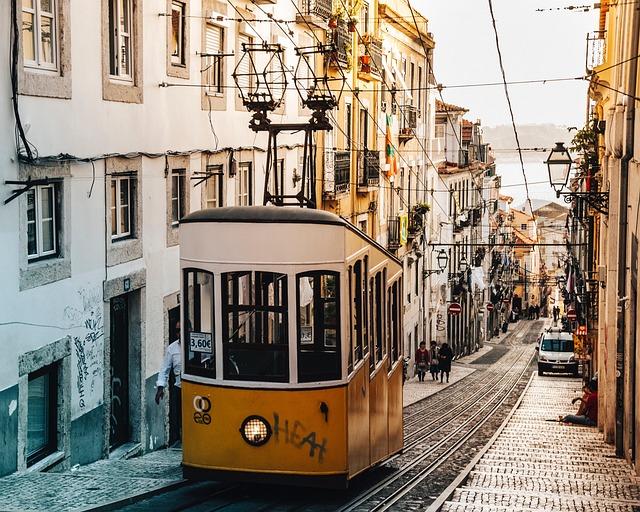Grenoble Resurrects Its Trams: A Model for Urban Revitalization
In an era where cities worldwide are grappling with the challenges of urban sprawl and environmental sustainability, Grenoble stands out as a beacon of innovation and resilience. Once a bustling hub for tram travel, the French city witnessed a dramatic decline in its tram system during the latter half of the 20th century, mirroring trends seen in many urban centers. However, in a remarkable turnaround, Grenoble has successfully resurrected its trams, redefining public transportation and enhancing the city’s livability. This article delves into the strategies and community-driven efforts that have fueled this transformation, offering a compelling case study for urban planners and policymakers aiming to create more sustainable and efficient cities. As Grenoble reinvests in its tram network, it not only prioritizes ecological considerations but also reimagines mobility in a way that prioritizes the needs of its residents.
Reviving a Transport Legacy: The History and Challenges of Grenoble’s Tram System
The modern era of Grenoble’s tram system is a testament to urban renewal and resilience in public transportation. Originally launched in the late 19th century, the tram service faded as automobile culture took precedence. However, by the 1980s, the city recognized the need to revitalize its public transport, and significant investments were made to restore and expand the tram network. Today, the system boasts a network that connects various neighborhoods, promoting not just mobility, but also environmental sustainability. Key features of this transformation include:
- Increased Accessibility: With an emphasis on making the trams accessible to all, including those with reduced mobility.
- Modern Infrastructure: The incorporation of energy-efficient trams reduces emissions and enhances ride comfort.
- Community Engagement: Local residents were involved in the planning process, ensuring that the tram network meets the community’s needs.
Despite its many successes, Grenoble’s tram system faces ongoing challenges. Integrating the tramway with other forms of transportation, such as buses and bicycles, remains complex. Moreover, maintaining a balance between expansion and the preservation of the city’s cherished historical sites poses a significant hurdle. The following table highlights some of the major challenges encountered:
| Challenge | Description |
|---|---|
| Funding | Securing continuous investment for maintenance and expansion projects. |
| Urban Congestion | Managing traffic flow while accommodating new tram lines. |
| Public Perception | Ensuring community support amid growing urban development. |
Innovative Integration: How Modern Technology Shaped the New Tram Network
Grenoble’s tram network has experienced a renaissance driven by cutting-edge technology that has transformed both infrastructure and user experience. The integration of modern systems has not only improved efficiency but also enhanced accessibility and sustainability. Key innovations include:
- Smart Ticketing Solutions: Mobile applications allow users to purchase tickets seamlessly, reducing queues and ensuring a smoother travel experience.
- Real-Time Tracking: GPS technology provides passengers with real-time updates on tram arrivals, helping to minimize wait times.
- Renewable Energy Sources: The new trams utilize electricity from renewable sources, significantly lowering the carbon footprint of public transport.
The implementation of these technologies required strategic collaboration between local government, transportation authorities, and tech companies. Notably, Grenoble’s urban planners focused on user-centric design, incorporating feedback from the community to fine-tune services. A collaborative effort resulted in:
| Innovation | Benefit |
|---|---|
| Smart Signal Prioritization | Reduces wait times at intersections, ensuring trams run on schedule. |
| LED Lighting | Enhances safety and visibility for passengers, especially during nighttime. |
Community Engagement in Urban Transit: Lessons Learned from Grenoble’s Revival Process
The revival of Grenoble’s tramway system encapsulates the power of community engagement in urban transit decisions. The process was not merely a top-down approach but a collaborative effort where local voices played a pivotal role. Through a series of public forums, workshops, and surveys, the city encouraged residents to express their views and concerns. This interaction laid the foundation for a design that was not only functional but also reflective of community identity. Key elements included:
- Inclusive Planning: Engaging citizens from diverse backgrounds to ensure a broad representation of needs.
- Transparent Communication: Keeping the public informed about progress, changes, and challenges throughout the project.
- Feedback Mechanisms: Implementing channels for continuous input allowed for adaptability and refinement of the design.
Furthermore, the integration of eco-friendly initiatives was a significant aspect of the planning process, responding not only to local demands but also aligning with global sustainability goals. Enhanced connectivity between residential areas and key urban hubs served as a vital component of the tram network, facilitating easier access to essential services. The following table outlines the core benefits observed post-implementation:
| Benefit | Description |
|---|---|
| Increased Ridership | Significant growth in daily users, contributing to reduced traffic congestion. |
| Environmental Impact | Decreased carbon emissions due to a shift from personal vehicles to public transport. |
| Enhanced Urban Aesthetics | Improved streetscapes that foster community engagement and tourism. |
Sustainable Mobility: Recommendations for Future Tram Developments in Urban Areas
As urban areas grapple with increasing congestion and pollution, the revival of tram systems emerges as a beacon of sustainable mobility. Cities like Grenoble have successfully integrated modern tram networks into their infrastructural framework, serving as a model for others. To enhance the effectiveness and appeal of future tram developments, cities should consider the following recommendations:
- Prioritize multimodal transport hubs: Integrating tram systems with bus, bike, and pedestrian pathways ensures smooth transitions and encourages the use of public transport.
- Incorporate green technologies: Utilizing electric trams with renewable energy sources will substantially reduce carbon footprints and enhance air quality in urban neighborhoods.
- Enhance accessibility: Making trams user-friendly for all demographics, including those with disabilities, will broaden ridership and community support.
- Engage local communities: Collaborating with residents during the planning phases fosters a sense of ownership and ensures the network meets their needs.
Moreover, adopting innovative design principles can rejuvenate urban landscapes. Cities should explore the following strategies to maximize the impact of tram developments:
| Strategy | Description |
|---|---|
| Mixed-use developments | Creating vibrant zones around tram stations boosts local businesses and increases foot traffic. |
| Dedicated tram lanes | Separating tram lines from regular traffic speeds up transit times and enhances reliability. |
| Smart ticketing systems | Implementing digital solutions simplifies fare collection and improves user experience. |
In Retrospect
In conclusion, Grenoble’s revival of its tram system serves as a compelling case study in urban transformation and sustainable transport solutions. With an emphasis on innovation and community engagement, the city has not only rejuvenated its public transportation network but also set a precedent for other cities grappling with similar challenges. The strategic investment in trams has not only streamlined urban mobility but has also contributed to reducing emissions and enhancing the overall quality of life for residents. As cities worldwide seek to embrace greener initiatives and modernize their infrastructure, Grenoble’s successful tram resurrection stands as a testament to the potential of thoughtful urban planning and commitment to sustainable development. As the city continues to expand and evolve, its trams will undoubtedly remain a pivotal element in shaping the future of urban connectivity and environmental stewardship.




